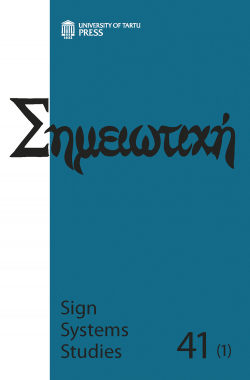Cognitive and linguistic underpinnings of <i>deixis am phantasma</i>: Bühler's and Peirce's semiotic
DOI:
https://doi.org/10.12697/SSS.2013.41.1.02Keywords:
Bühler, deixis, imagination, interpretant, Peirce, phantasyAbstract
Th is inquiry outlines Karl Bühle's three kinds of deixis, focusing particularly on his most advanced use – deixis am phantasma (deictics to refer to absent referents). This use is of primary import to the semiosis of index, given the centrality of the object and the interpretant in changing the function of the indexical sign in ontogeny. Employing deictic signs to refer to absent objects (some of which are mental) constitutes a catalyst from more social, conventional, uses to more internal, imaginative, ones. Bühler's analogy of mental objects as a "mimesis" serves as the genesis for the claim that static and more dynamic memories, fuelled by affect, drive deictics to refer to more dynamic objects and more dynamic interpretants, into more constructed realities. Peirce's two types of objects and three types of interpretants complete Bühler's deictic framework; they determine advances in deictic semiosis undeveloped by Bühler, and offer rationale for how it is that deictic use extends the semiosis of index.Downloads
Download data is not yet available.
Downloads
Published
2013-05-17
How to Cite
West, D. E. (2013). Cognitive and linguistic underpinnings of <i>deixis am phantasma</i>: Bühler’s and Peirce’s semiotic. Sign Systems Studies, 41(1), 21–41. https://doi.org/10.12697/SSS.2013.41.1.02
Issue
Section
Articles


